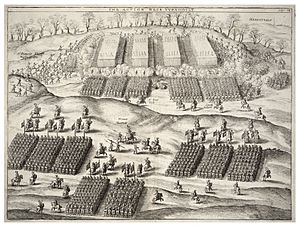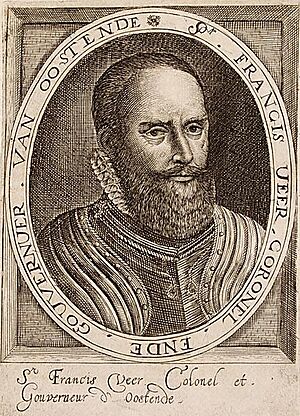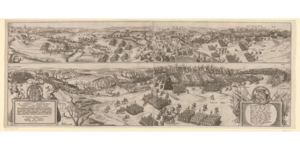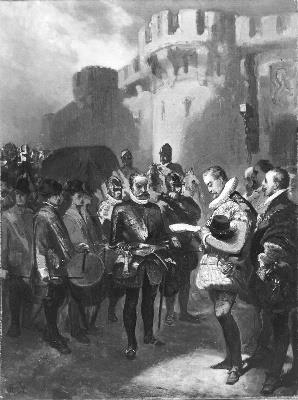Battle of Turnhout (1597) facts for kids
Quick facts for kids Battle of Turnhout |
|||||||
|---|---|---|---|---|---|---|---|
| Part of the Eighty Years' & Anglo-Spanish Wars | |||||||
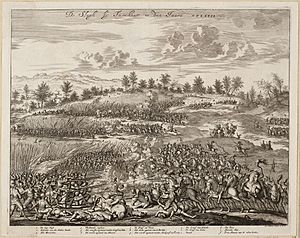 The battle of Turnhout in 1597. Engraving by Jan Luyken |
|||||||
|
|||||||
| Belligerents | |||||||
| Commanders and leaders | |||||||
| Strength | |||||||
| 4,000 infantry, 500 cavalry |
6,000 infantry (not engaged), 800 cavalry |
||||||
| Casualties and losses | |||||||
| 2,000 killed & wounded, 500 to 700 captured |
12 killed, 50 wounded |
||||||
The Battle of Turnhout, also known as the Battle of Tielenheide, was a big fight that happened on January 24, 1597. It was fought between the armies of the Dutch Republic and the Kingdom of England against the Spanish Empire.
This battle took place near Turnhout in what is now Belgium. It was an important part of two larger wars: the Eighty Years' War and the Anglo-Spanish War (1585–1604).
The Spanish army was trying to move from Turnhout to a safer, walled town called Herentals. Turnhout didn't have strong walls. The Dutch and English armies caught up with the Spanish on their way. After some smaller fights, both armies met on a wide, open field called Tielenheide.
The Spanish cavalry (soldiers on horseback) were quickly defeated. Then, the English and Dutch cavalry attacked the Spanish infantry (foot soldiers). The Spanish army was completely scattered and lost many soldiers.
Contents
Why the Battle Happened
Spain's Troubles and French Wars
After a successful attack on Cadiz in 1596, English soldiers led by Sir Francis Vere were needed back in the Netherlands. The attack on Cadiz caused Spain to run out of money for the third time. This meant that the Spanish soldiers often didn't get paid. When soldiers aren't paid, they sometimes refuse to follow orders.
Also, many Spanish troops had been sent from the Netherlands to France. They were helping the Catholic League in the French Wars of Religion. This made the Spanish army in the Netherlands weaker.
Spanish Plans in Turnhout
In the winter of 1596-1597, the Spanish army was led by Archduke Albert and Count Varax. They had about 4,500 soldiers. They moved to the town of Turnhout, which was about 30 kilometers south of the Dutch city of Breda. Their plan was to surprise and capture the town of Tholen during the winter.
Even though Turnhout didn't have strong walls, it was important because it had a small castle. This castle was surrounded by a moat and had a small group of 40 soldiers defending it.
Who Was Fighting?
The Spanish army had four groups of foot soldiers. These included soldiers from Naples, Germany, and Wallonia. Their cavalry, or horse soldiers, were led by Nicolo Basta. They had Spanish and Flemish units.
The Dutch army was led by Maurice of Nassau. He was ordered by the States General to gather an army at Geertruidenberg to stop the Spanish.
Maurice's army had almost 6,800 foot soldiers and some cannons. Sir Francis Vere led the English part of the army. About two-thirds of Maurice's army were actually English and Scottish soldiers. Many of these were professional soldiers hired by Elizabeth I, the Queen of England.
The cavalry for the Dutch and English side had 800 men. This included a special group of 100 elite horsemen from England. These were volunteers from noble families who supported the Protestant religion.
March to Battle
On the morning of January 23, 1597, the Dutch and English army left Geertruidenberg. They marched very quickly, covering 38 kilometers in one day, even though the roads were bad. They reached the village of Ravels that evening, which was close to Turnhout.
At midnight, the army packed up their camp and moved towards Turnhout.
The Battle Begins
Count Varax, the Spanish commander, heard that Maurice's army was much bigger than it actually was. Because Turnhout had no strong walls, he decided to leave immediately. He ordered his army to retreat south to the fortified town of Herentals.
By dawn on January 24, the entire Spanish force was on its way to Herentals. Maurice soon found out that the Spanish had just left Turnhout. The area had many hedges and ditches. When the Spanish reached the Aa river, Varax removed most of the planks from the wooden bridge. Spanish musketeers (soldiers with guns) were placed on the other side to stop anyone from crossing. However, the English advance guard quickly forced them away.
The Chase and Skirmishes
English horsemen and musketeers were sent ahead to follow the Spanish army. They started a small fight that continued for 8 kilometers. Dutch musketeers crossed the bridge, while others, with the cavalry, crossed the river at a nearby shallow spot.
The Spanish were now in full retreat. Maurice ordered all of his cavalry to chase them. His foot soldiers and cannons were left far behind, struggling on the muddy road.
Sir Francis Vere found a large wood further from the river. He placed his musketeers along the edges of the wood to hide them. These soldiers kept firing at the Spanish rear guard (the last part of their army). Vere, with 16 horsemen, followed the Spanish on the main road. He also sent a message to Maurice asking for support. Vere's horse was shot, and he was slightly wounded in the leg, but he kept leading on foot until he got another horse.
This chase between the Anglo-Dutch scouting force and the Spanish rear guard lasted for more than three hours. Finally, the main group of the allied cavalry arrived. By then, the Spanish had reached Tielenheide, an open field perfect for cavalry fighting.
The Main Attack
Varax arranged his foot soldiers into four strong squares of pikemen (soldiers with long spears). They marched south across the open field. Musketeers were placed on the sides, as was common for the Spanish army. His cavalry and supply wagons had already entered a narrow lane beyond the field.
The first group of Spanish soldiers were Germans. They were followed by Walloon and Burgundian soldiers. The most experienced Spanish and Italian troops were at the very back. Vere kept following them until all of Maurice's cavalry had joined him on the field. The Anglo-Dutch cavalry then lined up in front of the Spanish.
The Spanish continued their march. But when they saw the allied movements on their left, their cavalry changed position. They moved from the right side to the left side of their line, riding between their foot soldiers and a line of trees. After the first shots from Vere's musketeers, the Spanish soldiers with guns on foot broke and ran away.
Varax ordered his cavalry to cover the retreat. But Count Hohenlohe and his Dutch cavalry charged the Spanish right side. Vere followed, attacking their rear. Hohenlohe attacked the German soldiers, while Vere's English cavalry and Bacx's Dutch cavalry attacked the Spanish rear guard.
The attack was a complete surprise. The Spanish cavalry, including famous groups, were hit hard and quickly retreated into the narrow lane. Most of them escaped into the muddy ground beyond. Some of Parker's cavalry chased the Spanish cavalry and their wagons down the Herentals road.
Spanish Defeat
With the Spanish cavalry gone, the Dutch and English cavalry attacked the confused Spanish foot soldiers. The Walloon groups tried to form a line, using a small group of trees for protection. But they were already scared after seeing their cavalry run away. When they saw the large group of Dutch foot soldiers coming to help their cavalry, they broke ranks. They tried to swim across the Aa river to reach Herentals.
The musketeers from Sultz's group fell back in confusion onto the pikemen behind them. The whole group quickly surrendered when the Anglo-Dutch cavalry charged them. The experienced Spanish troops under Treviso fought bravely for a while. But Vere and Bacx's charge was too strong. The Dutch and English horsemen rode very close to the Spanish soldiers. They fired their pistols and carbines from very close range, causing terrible damage. Varax, the Spanish commander, was fighting at the front and was killed. The cavalry's fire created gaps in the Spanish lines. The horsemen rode into these gaps and attacked from inside, quickly causing the Spanish to run away.
While the experienced Spanish troops were fighting, the remaining Germans and other foot soldiers were also defeated. The panicked survivors ran into the other two Spanish groups, blocking their fire and spreading panic. The English and Dutch quickly broke these groups too, sending almost all the Spanish foot soldiers running. The chasing cavalry hunted them down, and the Spanish soldiers were "cut down with terrible slaughter." Parker's cavalry had gone through the narrow lane and stolen the Spanish supply wagons. The Spanish had been completely defeated. The entire battle lasted no more than half an hour.
The few Spanish soldiers who survived managed to retreat to Herentals. There, Nicolo Basta took command and gathered the remaining soldiers.
After the Battle
Out of 4,000 Spanish foot soldiers and 500 horsemen, almost half were killed or wounded. About 2,000 were killed or injured. Also, 38 flags were captured, and around 600 Spanish soldiers were taken prisoner.
The Dutch and English forces had very few losses. Only 50 were injured, and 10 were killed. The entire battle was won by about 800 Dutch and English horsemen. Most of the Dutch foot soldiers didn't even get to fight.
That night, the winners rested in Turnhout. The next morning, the castle there surrendered. The Dutch then burned parts of it. However, Maurice had to leave the town after a few days. This was because Spanish reinforcements, led by Archduke Albert, were arriving. The allied army then marched back to Geertruidenberg. The victory at Turnhout was important, but it didn't lead to any big, long-term gains for the Dutch and English.
On February 8, Maurice returned to The Hague. The captured Spanish flags were shown in the Ridderzaal (the main government building) as a sign of victory. The prisoners were treated well, and the wounded were cared for. The body of the Spanish commander, Varax, was sent back to Archduke Albert. In return, Albert promised to be kind to Dutch prisoners too.
The English soldiers under Vere and Sidney fought very well. Both generals praised each other. Vere thought Sidney was excellent in battle, being one of the first to charge. Sidney said the victory was only because of Vere.
News of the victory was celebrated greatly in England. People sent many congratulations. The battle was even turned into a play in London, called the Overthrow of Turnholt. All the officers who were there were played by actors.
Cultural Impact
The composer Kevin Houben wrote a musical piece called Thyellene: The Battle on the Heath to remember the battle. In September 2008, a band played this music at the actual battle site.
The victory at Turnhout also inspired the writing of a famous Dutch hymn, We Gather Together.
See also
 In Spanish: Batalla de Turnhout (1597) para niños
In Spanish: Batalla de Turnhout (1597) para niños


